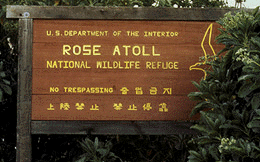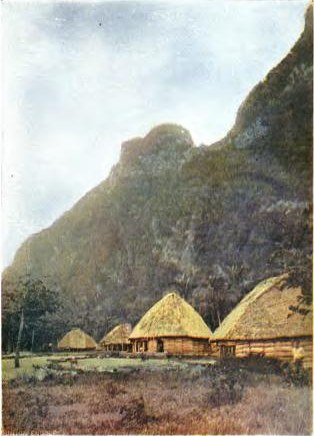|
Rose Island Concrete Monument
The Rose Island Concrete Monument is a historic commemorative marker on Rose Island, part of Rose Atoll, a remote island located in the far eastern reaches of the territorial waters of American Samoa. The marker is a concrete structure in the shape of a truncated pyramid with a rectangular cross-section. It is wide, high, and deep. On the west side of the marker is raised lettering stating "ROSE ISLAND / AMERICAN SAMOA / TRESPASSING PROHIBITED / WARREN J. TERHUNE / JAN 10 1920 GOVERNOR". A brass plaque on the opposite side of the monument conveys a similar message. The monument was placed in 1920 by the order of Naval Governor Warren J. Terhune during a tour he made of all of the islands of the territory of American Samoa, and serves as a continuing reminder of the American claim to the atoll. The monument was listed on the National Register of Historic Places in 2013. See also *National Register of Historic Places listings in American Samoa File:American Samoa District ... [...More Info...] [...Related Items...] OR: [Wikipedia] [Google] [Baidu] |
Rose Atoll
Rose Atoll, sometimes called Rose Island or Motu O Manu ("Bird Island") by people of the nearby Manu'a Islands, is an oceanic atoll within the U.S. territory of American Samoa. An uninhabited wildlife refuge, it is the southernmost point belonging to the United States. The land area is just at high tide. The total area of the atoll, including lagoon and reef flat amounts to . Just west of the northernmost point is a channel into the lagoon, about 40 m wide. There are two islets on the northeastern rim of the reef, larger Rose Island in the east (3.5 m high) and the non-vegetated Sand Island in the north (1.5 m high). The Rose Atoll Marine National Monument that lies on the two outstanding islands of the Atoll is managed cooperatively between the U.S. Fish and Wildlife Service and the government of American Samoa. History The earliest Western sighting was June 13, 1722, during the voyage of Jacob Roggeveen, who called it ''Vuil Eiland'' "useless island." The name Rose Isla ... [...More Info...] [...Related Items...] OR: [Wikipedia] [Google] [Baidu] |
American Samoa
American Samoa ( sm, Amerika Sāmoa, ; also ' or ') is an unincorporated territory of the United States located in the South Pacific Ocean, southeast of the island country of Samoa. Its location is centered on . It is east of the International Date Line, while Samoa is west of the Line. The total land area is , slightly more than Washington, D.C. American Samoa is the southernmost territory of the United States and one of two U.S. territories south of the Equator, along with the uninhabited Jarvis Island. Tuna products are the main exports, and the main trading partner is the rest of the United States. American Samoa consists of five main islands and two coral atolls. The largest and most populous island is Tutuila, with the Manuʻa Islands, Rose Atoll and Swains Island also included in the territory. All islands except for Swains Island are part of the Samoan Islands, west of the Cook Islands, north of Tonga, and some south of Tokelau. To the west are the islands ... [...More Info...] [...Related Items...] OR: [Wikipedia] [Google] [Baidu] |
United States Navy
The United States Navy (USN) is the maritime service branch of the United States Armed Forces and one of the eight uniformed services of the United States. It is the largest and most powerful navy in the world, with the estimated tonnage of its active battle fleet alone exceeding the next 13 navies combined, including 11 allies or partner nations of the United States as of 2015. It has the highest combined battle fleet tonnage (4,635,628 tonnes as of 2019) and the world's largest aircraft carrier fleet, with eleven in service, two new carriers under construction, and five other carriers planned. With 336,978 personnel on active duty and 101,583 in the Ready Reserve, the United States Navy is the third largest of the United States military service branches in terms of personnel. It has 290 deployable combat vessels and more than 2,623 operational aircraft . The United States Navy traces its origins to the Continental Navy, which was established during the American Re ... [...More Info...] [...Related Items...] OR: [Wikipedia] [Google] [Baidu] |
Warren J
A warren is a network of wild rodent or lagomorph, typically rabbit burrows. Domestic warrens are artificial, enclosed establishment of animal husbandry dedicated to the raising of rabbits for meat and fur. The term evolved from the medieval Anglo-Norman concept of free warren, which had been, essentially, the equivalent of a hunting license for a given woodland. Architecture of the domestic warren The cunicularia of the monasteries may have more closely resembled hutches or pens, than the open enclosures with specialized structures which the domestic warren eventually became. Such an enclosure or ''close'' was called a ''cony-garth'', or sometimes ''conegar'', ''coneygree'' or "bury" (from "burrow"). Moat and pale To keep the rabbits from escaping, domestic warrens were usually provided with a fairly substantive moat, or ditch filled with water. Rabbits generally do not swim and avoid water. A '' pale'', or fence, was provided to exclude predators. Pillow mounds The most c ... [...More Info...] [...Related Items...] OR: [Wikipedia] [Google] [Baidu] |
National Register Of Historic Places
The National Register of Historic Places (NRHP) is the United States federal government's official list of districts, sites, buildings, structures and objects deemed worthy of preservation for their historical significance or "great artistic value". A property listed in the National Register, or located within a National Register Historic District, may qualify for tax incentives derived from the total value of expenses incurred in preserving the property. The passage of the National Historic Preservation Act (NHPA) in 1966 established the National Register and the process for adding properties to it. Of the more than one and a half million properties on the National Register, 95,000 are listed individually. The remainder are contributing resources within historic districts. For most of its history, the National Register has been administered by the National Park Service (NPS), an agency within the U.S. Department of the Interior. Its goals are to help property owners a ... [...More Info...] [...Related Items...] OR: [Wikipedia] [Google] [Baidu] |
National Register Of Historic Places Listings In American Samoa
File:American Samoa Districts.png, 250px, American Samoa districts (clickable) poly 520 1249 517 1248 482 1247 473 1230 456 1230 450 1237 440 1228 432 1218 428 1216 432 1210 431 1202 429 1198 429 1190 434 1182 438 1180 420 1158 393 1137 396 1133 382 1123 362 1091 598 921 645 908 821 907 1024 895 1023 1153 Eastern District poly 1772 1436 2018 1439 2034 1213 2002 1084 1795 946 1470 937 1105 949 1138 1154 Manu'a District poly 336 1467 453 1405 585 1264 516 1247 491 1247 482 1247 476 1240 473 1234 473 1230 468 1230 460 1230 453 1231 453 1237 449 1237 442 1231 434 1225 428 1215 431 1209 431 1197 428 1191 433 1180 436 1180 438 1176 420 1161 393 1139 394 1131 382 1125 360 1090 282 1024 76 1007 14 1249 166 1347 247 1417 Western District desc none This is a list of the buildings, sites, districts, and objects listed on the National Register of Historic Places in American Samoa. There are currently 31 listed sites spread across the three districts of American Samoa. There are no ... [...More Info...] [...Related Items...] OR: [Wikipedia] [Google] [Baidu] |
History Of American Samoa
The islands of Samoa were originally inhabited by humans as early as 850 BC. After being invaded by European explorers in the 18th century, by the 20th and 21st century, the islands were incorporated into Samoa (Western Samoa, Independent Samoa) and American Samoa (Eastern Samoa). Early history of the Polynesian people of Samoa The pre-colonial history of Eastern Samoa (now American Samoa) is inextricably bound with the history of Western Samoa (now independent Samoa). The Tui Manu'a is one of the oldest Samoan titles in Samoa. Traditional oral literature of Samoa and Manu'a talks of a widespread Polynesian network or confederacy (or "empire") that was prehistorically ruled by the successive Tui Manu'a dynasties. Manuan genealogies and religious oral literature also suggest that the Tui Manu'a had long been one of the most prestigious and powerful paramounts Samoa. Legends suggest that the Tui Manu'a kings ruled a confederacy of far-flung islands which included Fiji, Tonga as ... [...More Info...] [...Related Items...] OR: [Wikipedia] [Google] [Baidu] |
Monuments And Memorials On The National Register Of Historic Places
A monument is a type of structure that was explicitly created to commemorate a person or event, or which has become relevant to a social group as a part of their remembrance of historic times or cultural heritage, due to its artistic, historical, political, technical or architectural importance. Some of the first monuments were dolmens or menhirs, megalithic constructions built for religious or funerary purposes. Examples of monuments include statues, (war) memorials, historical buildings, archaeological sites, and cultural assets. If there is a public interest in its preservation, a monument can for example be listed as a UNESCO World Heritage Site. Etymology It is believed that the origin of the word "monument" comes from the Greek ''mnemosynon'' and the Latin ''moneo'', ''monere'', which means 'to remind', 'to advise' or 'to warn', however, it is also believed that the word monument originates from an Albanian word 'mani men' which in Albanian language means 'remembe ... [...More Info...] [...Related Items...] OR: [Wikipedia] [Google] [Baidu] |
Buildings And Structures On The National Register Of Historic Places In American Samoa
A building, or edifice, is an enclosed structure with a roof and walls standing more or less permanently in one place, such as a house or factory (although there's also portable buildings). Buildings come in a variety of sizes, shapes, and functions, and have been adapted throughout history for a wide number of factors, from building materials available, to weather conditions, land prices, ground conditions, specific uses, prestige, and aesthetic reasons. To better understand the term ''building'' compare the list of nonbuilding structures. Buildings serve several societal needs – primarily as shelter from weather, security, living space, privacy, to store belongings, and to comfortably live and work. A building as a shelter represents a physical division of the human habitat (a place of comfort and safety) and the ''outside'' (a place that at times may be harsh and harmful). Ever since the first cave paintings, buildings have also become objects or canvasses of much artisti ... [...More Info...] [...Related Items...] OR: [Wikipedia] [Google] [Baidu] |






